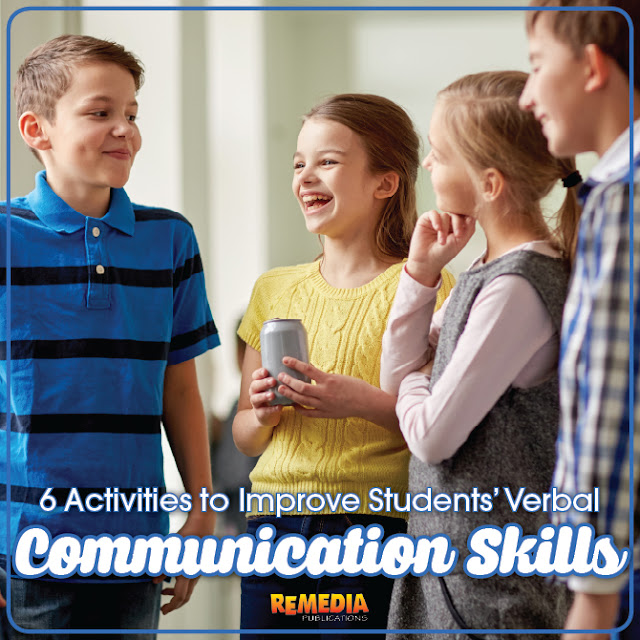Verbal communication can be difficult–even for adults! It’s one life skill we inarguably all need to work on. And the more practice we can give to our students early on, the better off they will be in the future.
“I came to realize that conversational competence might be the single-most overlooked skill we fail to teach students,” said Paul Barnwell in the article, “My Students Don’t Know How to Have a Conversation” from The Atlantic. The article is about one teacher’s concerns regarding how on-screen communication had diminished his students’ engagement and abilities in “real-time talk.”
Don’t worry though! We’re here to help. Below are six fun games that will get your whole class talking–not just talking–communicating.
Feed Me
This messy game is fun and will get your students communicating and improving their ability to give instructions. You’ll need three participants. Blindfold one person; this person is the “feeder.” The second person will be fed. The third person will give the blindfolded “feeder” instructions on how to manage to get a spoonful of peanut butter, pudding, or applesauce into the other person’s mouth. We recommend that you play this game outside and while wearing a smock.
Teach Me
Believe it or not, kids do actually know a few things that adults don’t. Have your kids teach you something like how to play that new game they’re obsessed with playing, whether it’s an app, computer game, video game, or board game. Encourage them to teach you verbally, not just show you how they play. They may struggle at first to gather their words and thoughts, so ask lots of questions. In the end, your child will have gained some valuable communication skills and you’ll have a new game to play together.
Hire Me
Your older students are probably already thinking about getting a weekend job, and they’ll need good communication skills to land the part-time job they are hoping for. So give them lots of practice. Some of the most common interview questions are sometimes hard for adults who have been to a lot of interviews, so prepare students by having students write their answers to these questions on a piece of paper. Then conduct an “interview” with each student. Use their answers to the questions as a “resume” so you that know what job they are applying for, as well as to help you ask off-the-cuff questions. Plus you’ll be able to assess their verbal communication skills versus their written skills. You could also have students pair-up and interview each other.
This unit will give students practice filling out a job application!
Call Me
Little ones love to play “phone.” Give them an old phone and they’ll talk for hours to no one about anything. So why not have your eight-year-old or even teenage students play this game of pretend.
With your younger students, try using the phone face-to-face. Start with, the basics: Hello. Who am I speaking with? How are you? And move on to open-ended questions. What will you have for lunch today? Who do you eat lunch with? Is that person your best friend? Why is that person your best friend? How did you meet?
For your older students, use real phones to call each or have students call each other in class from across the room. Give them a few things that they must find out about the person they are speaking to. This will get them thinking about questions to ask while also get them talking and answering questions. Require them to spend at least 5-10 minutes on the phone. Challenge them! The pair of students who find out the most information about each other in 10 minutes wins! Use these free phone topics.
Follow Me
This game is great for whole-class participation. Your students will love playing this twist on Follow the Leader while working on their communication skills. First, choose one person to be blindfolded (or not)—this person could be you. Hide an object like a ball at the back of the classroom, somewhere on the playground, on the ground, or in a drawer to create some complexity to this game.
Have the blindfolded person stand quite a distance away from the hidden object—like the front of the classroom. Each student in the class will take turns giving one instruction to the blindfolded person that helps them get closer to picking up the object. For example, Student 1: take two steps forward; Student 2: there’s a desk in front of you, so sidestep twice to the left; Student 3: take four small steps forward…and so on.
Students can practice the Follow Me communication and following directions game skills game with this unit.
Guess Me
Have students bring in a Show and Tell item inside a paper bag or box. Have each student present their item by giving clues as to what is inside their box without telling what is actually inside the box. For example, I got this object on my summer vacation to Seattle. After we went to the very top of a very famous, tall building, my mom allowed me to buy one souvenir. I chose this… At the end of each presentation, allow the class to make guesses. Depending on their communication skills, the guessing may or may not be successful.
Similarly, you could play 21-Questions. Each student gets a turn asking a “yes” or “no” question of the student who is presenting his/her item. At the end, students use the clues to guess what the presenter has brought for Show and Tell.
Students can practice the Guess Me communication and critical thinking skills game with this unit.












